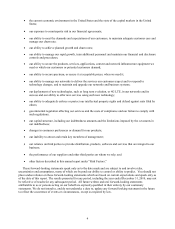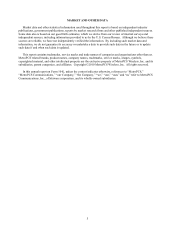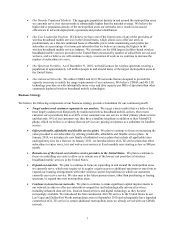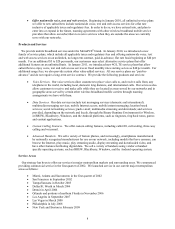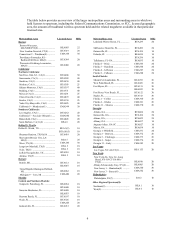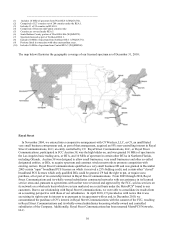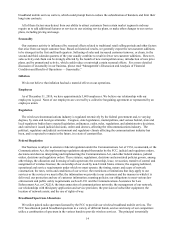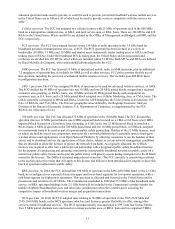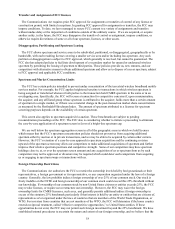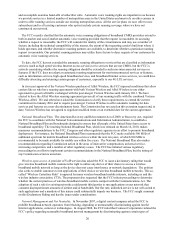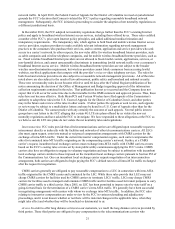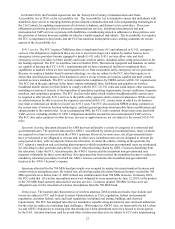Metro PCS 2010 Annual Report Download - page 24
Download and view the complete annual report
Please find page 24 of the 2010 Metro PCS annual report below. You can navigate through the pages in the report by either clicking on the pages listed below, or by using the keyword search tool below to find specific information within the annual report. 14
broadband mobile services carriers, which could prompt them to reduce the subsidization of handsets and limit their
long term contracts.
All of these factors may detract from our ability to attract customers from certain market segments and may
require us to add additional features or services to our existing service plans, or make other changes to our service
plans, including pricing and usage.
Seasonality
Our customer activity is influenced by seasonal effects related to traditional retail selling periods and other factors
that arise from our target customer base. Based on historical results, we generally expect the net customer additions
to be strongest in the first and fourth quarters. Softening of sales and increased customer turnover, or churn, in the
second and third calendar quarters of the year usually combine to result in fewer net customer additions. However,
sales activity and churn can be strongly affected by the launch of new metropolitan areas, introduction of new price
plans, and by promotional activity, which could reduce or outweigh certain seasonal effects. For a more detailed
discussion of seasonality in our business, please read “Management’s Discussion and Analysis of Financial
Condition and Results of Operations — Seasonality.”
Inflation
We do not believe that inflation has had a material effect on our operations.
Employees
As of December 31, 2010, we have approximately 3,600 employees. We believe our relationship with our
employees is good. None of our employees are covered by a collective bargaining agreement or represented by an
employee union.
Regulation
The wireless telecommunications industry is regulated extensively by the federal government and, to varying
degrees, by state and local governments. Congress, state legislatures, municipalities, and various federal, state and
local regulatory bodies have enacted legislation, ordinances, codes, rules, regulations, and administrative decisions,
and courts have issued judicial decisions, orders and decrees, affecting the telecommunications industry. The
political, regulatory and judicial environment and regulatory climate affecting the communications industry has
been, and is expected to remain in the future, in a state of constant flux.
Federal Regulation
Our business is subject to extensive federal regulation under the Communications Act of 1934, as amended, or the
Communications Act, the implementing regulations adopted thereunder by the FCC, judicial and regulatory orders,
decisions and decrees interpreting and implementing the Communications Act, and other federal statutes, judicial
orders, decisions and regulatory orders. These statutes, regulations, decisions and associated policies govern, among
other things, the allocation and licensing of radio spectrum; the ownership, lease, revocation, transfer of control and
assignment of wireless licenses; the ownership of our stock by non-United States citizens; the ongoing technical,
operational and service requirements under which we must operate; the timing, nature and scope of network
construction; the rates, terms and conditions of our service; the restrictions or limitations that may apply to our
services or the services we must offer; the information we provide to our customers and the manner in which it is
delivered; our protection and use of customer information; roaming policies; our obligations to meet various law
enforcement and public safety requirements such as E-911 and the Communications Assistance for Law
Enforcement Act, or CALEA; the interconnection of communications networks; the management of our network;
our relationships with third-party application and service providers; the provision of subscriber equipment; the
location of network assets; and the use of rights of way.
Broadband Spectrum Allocations
We utilize paired radio spectrum licensed by the FCC to provide our wireless broadband mobile services. The
FCC has allocated paired broadband spectrum in a variety of different bands, and we and many of our competitors
utilize a combination of spectrum in the various bands to provide wireless services. The principal terrestrially


